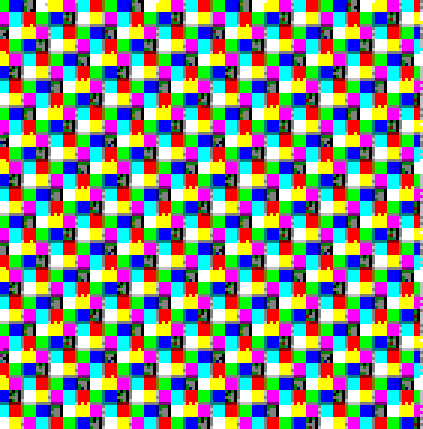View current page
...more recent posts

Photo by Justine Kurland, from "The Secret World of Girls" ("perhaps the most profound photographic series of this or any other century" --J. Saltz)
Just kidding, the actual attribution is "LiveJournal - artist unknown." Kevin has a good suggested caption in the comments to this post: "Take Your Daughter to Work Day is taken to a tragic but hilarious extreme."
Church of Lo Fi
A friend just jokingly referred to my preference for old computer programs over current software as my "religion." No, religion is believing you have to buy the newest program to make the best art. The opposite of that is...iconoclasm?
But idol-smashing can be dogmatic, too, so maybe it's better to couch the discussion in terms of "desired artistic effects." My old dying Mac SE makes cool sounds from the clipping and distortion that comes from "overdriving" the machine's limited synths, just in normal use--rhythmic patterns of clicks, ominous atmospheric rumbles... You won't get that with garageband (or maybe there's a pallette called "old Mac flaws"? I don't really want to hear about it). Also, there's something about working against limitations, as opposed to having a machine that "does it all for you." Think movie special effects on a budget vs profligate CGI. And finally, there's a certain exoticism of hearing/seeing old tools as they were before years of "improvements." Some of those improvements are engineering tweaks (for speed, etc) but others are simple value judgments the user had no input in. As Dan Graham once said--in so many words, and not necessarily for this reason--the "recently outmoded" can be one of the more fertile and radical places for artists to work.
Anyway, if lo fi is a religion, here's a chapter of the Bible, written by painter Alexander Ross for the "Static" show co-organized by John Pomara and me in '98 (I especially like the bolded para.):
The Recent History of Static in Recorded Music
by Alexander Ross
The static trend in rock music grew initially out of the fuzz guitar sound (best known from the Rolling Stones' "[I Can't Get No] Satisfaction"), which imitated an over-driven or distorting amplifier. Hard-rock outfits continued to push the "guitar wall of sound" well after the '60s, refining it into a subtle and controlled art.
The creative fringe took interest in an accidental by-product of this distortion: the overtones of fuzz, a warm "pink noise" (white noise is static without tone, pink noise is static or "snow" with a hum, or discernible pitch) that rode seemingly independently on top of the music. An early exploration of this might be Eno's "Needle in the Camel's Eye" from 1973, where the constant smashing of guitar chords creates a wall of wavering noise above the song.
A foundational work appeared in the mid-'70s with Lou Reed's controversial and fan-disappointing double LP Metal Machine Music, an all-static-and-feedback statement that figures in rock history much the way Futurist noise performances function in the history of theatre: pure, unequivocal rebellion.
There were some notable static undergrounds coming along in the late '70s/early 80's, namely Chrome (out of San Francisco), and a little later Fi (pronounced "eff eye"). Throbbing Gristle might also be mentioned here, as well as This Heat and Cabaret Voltaire (for example, "No Escape" off their classic first release, Mix-Up). The first group to make the intentional breakthrough into pure static would have to be The Jesus & Mary Chain, who eq-ed the bass-end off the fuzz chords entirely, leaving a shrill, static constant running relentlessly throughout their songs. Next would be Kevin Shields of My Bloody Valentine, where the static becomes more textured and smeared, literally permeating the music. The effect is a sexy, dreamlike blur echoing early '90s trends in fashion photography. Static finally becomes the main subject with the rise of Flying Saucer Attack (Chorus is a good example), out of Virginia, of all places. Here the static is totally frontal, and the music sort of whispers at you through a snowy haze.
The advent of the compact disc in all its sterile flawlessness brought about the realization that technological defects such as tape hiss, amp buzz, record groove ticks, and ultimately the computerized glitches sometimes heard on the CD itself were now interesting sounds never before utilized in conjunction with music. This, combined with the inexpensive home recording boom, coalesced into what became known as LO-FI. Major players, largely confined to the US and New Zealand, include Lou Barlow/Sentridoh, Daniel Johnston, Guided By Voices, and (from New Zealand) post-rockers The Dead C and This Kind of Punishment.
Mid-'90s developments quickly cross-over into the techno-ambient realms with Oval, who boldly dominate the glitch and hiss scene. Mention should be made of Scanner, an individual who scans cell phone conversations and create pieces out of them, with the natural static of the transmission wavering in and out. Most recently is Porter Ricks, also techno-ambient, whose distant discotheque is heard pleasantly through walls of dreamy smush.
The ambient/industrial sector was long-ago onto the static phenomenon, but here there is no music at all, just pure, wonderful noise. Examples here would be The Hafler Trio, Arcane Device, Tibetan Red, PBK, and early Nocturnal Emissions.
Downloadin on the beach or downloadin from TV
Two or a billion sharers, it means nothin to she
Teenagers and grannies is who she likes to do
But then I'm sure you know she's comin' after you.
Her name is R1AA and she sues you for The Man
Just like a river twistin' through a clickin' land...
And when she sues you she does it 'cause she can
Oh R1AA R1AA suin' for The Man.

MusicWorks for Macintosh was one of the first music software programs for home consumption (ca 1984); it takes up a whopping 69K of memory. I still use it: it acts as a primitive sequencer, letting me cut and paste loops that I write into some kind of coherent (hopefully catchy) song or composition. It gets a nice, unsophisticated video game sound, with about 10 "instruments"--e.g., piano, organ, trumpet (uggh), chime, synth 1, synth 2--and controls for the attack and decay as well as tremolo and vibrato. The pieces I did in '88, when the computer was relatively new, are more structured (i.e. songlike) than the most recent stuff, which is more "tracklike" and features found sound (other folks' lock grooves from turntables, etc.). A new composition will be posted soon, something I'm pretty happy with--a score for another artist's video--that's more in the '88 spirit.
Unfortunately the ancient Mac SE I run MusicWorks on seems to be dying; it takes longer and longer to save and I've lost some work. I like this little music program a lot--it's sort of the aural equivalent of MSPaintbrush, which I'm also fixated on--and I'm hoping it can be run on the newer Macs. If it can I'll plunk down and buy one.

Enlarged detail of animated GIF by Hideki Nakazawa, creator of Digital Nendo.
If you're visiting New York be sure to check out Paper Rad's show at Foxy Production, through May 29. This three-person collective makes video, paintings, drawing, clothing, and artist books with a kind of transcendental, cyberhippie-meets-kid's-show vibe. There are other artists working along similar lines, notably dearraindrop, but 'Rad seems closer to the old Russian constructivist spirit of integrating media and styles into a "unified work": a continuum running from Shockwave sunburst effects to van-style airbrush to simple watercolors to sewn fabric. Think Yellow Submarine, Rubik's cube, mid-90s homepage design, Gary Panter, and for a really obscure reference, the early 70s psychedelic illustration of Bob Brockway and Brad Johannsen. Installationwise, instead of jamming everything into a room (as dearraindrop did), the Foxy show is measured, geometric, and has breathing spaces; the six monitor video stack, featuring contributions by each member in a kinetic, ever-changing repertoire, is exceptional. An earlier video worth seeing is gumby: life is a mister-e: Gumby is too depressed to go on his birthday trip to outer space, so God's arm comes down from a cloud and gently massages away his troubles (and his head). Childlike and disturbing.
Paper Rad: Detail from Weekly Comic.
A couple of cell phone camera pics from the opening by bloggy
Is it possible Jonathan Lethem is a better critic than fiction writer? Motherless Brooklyn aside, his essays on popular culture, especially comics and science fiction, seem more urgent and hilarious to me than his books. I'm thinking specifically of his essays in Bookforum on the secret shame of being a Marvel Comics fan and the sometimes anticlimactic ecstasies of discovering old Philip K. Dick paperbacks in used bookstores ("Vulcan's fucking Hammer! I'd found it! Of course, then I had to go and read the damn thing."). Even in Motherless, some of the highest spots were the little vignettes on pop culture, e.g. Prince ("The way he worried forty five minutes of variations out of a lone musical or verbal phrase is, as far as I know, the nearest thing in art to my condition [Tourette's]") and Mad Magazine's Don Martin ("Mad often held the concluding panel of a Martin cartoon to the following page, and part of the pleasure of his work was never knowing whether the payoff would be a visual pun or verbal riff or merely the sight of a man in a full-body cast falling out of the window into the path of a steamroller."). The following recent thoughts on Marvel Comics in the London Review of Books are also good, despite being framed by rather ordinary juvenile reminiscing:
In Marvel's greatest comics, [writer Stan] Lee and [artist Jack] Kirby were full collaborators who, like Lennon and McCartney, really were more than the sum of their parts, and who derived their greatness from the push and pull of incompatible visions. Kirby always wanted to drag the Four into the Negative Zone - deeper into psychedelic science fiction and existential alienation - while Lee resolutely pulled them back into the morass of human lives, hormonal alienation, teenage dating problems, pregnancy, and unfulfilled longings to be human and normal and loved and not to have the Baxter Building repossessed by the City of New York. Kirby threw at the Four an endless series of ponderous fallen gods or whole tribes and races of alienated antiheroes with problems no mortal could credibly contemplate. Lee made certain the Four were always answerable to the female priorities of Sue Storm - the Invisible Girl, Reed Richards's wife and famously 'the weakest member of the Fantastic Four'. She wanted a home for their boy Franklin, she wanted Reed to stay out of the Negative Zone, and she was willing to quit the Four and quit the marriage to stand up for what she believed.After reading this careful, historically accurate exegesis I'm still mystified why Lethem flubbed some of the references in Fortress of Solitude (see earlier post). Let's save for another time why reading about our (I mean, my) pop-cultural past strikes a deeper chord than revisiting the day to day agony and boredom of 7th and 8th grade. (hat tip to Travelers Diagram for spotting Maud Newton's spotting of the essay)I seriously doubt whether any 1970s Marvel-loving boy ever had a sexual fantasy about Sue Storm. We had Valkyrie, Red Sonja, the Cat, Ms Marvel, Jean Grey, Mantis and innumerable others available for that. We (I mean, I) especially liked the Cat. Sue Storm was truly invisible. She was a parent, a mom calling you home from where you played in the street, telling you it was time to brush your teeth. Not that she wasn't a hottie, but Kirby exalted her beauty in family-album style headshots, and glimpses of her, nobly pregnant, in a housedress that covered her clavicle. The writers and artists who took over The Fantastic Four after Kirby and, later, Lee departed the series, seemed impatient with the squareness of Sue and Reed's domestic situations. Surely, these weren't the hippest of the Kirby/Lee creations. Nevertheless, if you (I mean, I) accept my premise that the mid-to-late 1960s Fantastic Four were the exemplary specimens, the Revolver and Rubber Soul and White Album of comics, and if you further grant that pulling against the tide of all of Kirby's inhuman galactacism, that whole army of aliens and gods, was one single character, our squeaky little Sue, then I wonder: Invisible Girl, the most important superhero of the Silver Age of comics?
Paul Berman, a so-called "liberal hawk," is back on the New York Times op-ed page today selling his particular brand of snake oil (annotated version here). You'd think this ideologue, whose left-leaning pro-war views were often sought out by editorial page editors in the run-up to the invasion to balance...well, all the right-leaning pro-war views, might be hanging his head in embarrassment at the current debacle. But no, he urges us to stay the course to combat his particular bugbear, Islamofascism. Based on his scholarly "discovery" of a sort of Islamic Mein Kampf written by an obscure theologian named Sayyid Qutb, Berman believes that all the diverse Muslim peoples (Arabs, Persians, Pakistanis) can be--are being--united by a paranoid millenarian philosophy that will eventually overcome all sectarian, nationalistic differences and cause Mohammed's followers to goose-step as one. So powerful is this "death-loving" cult that it even includes secular states such as (the former) Baathist Iraq.
By inventing a Unified Menace to replace the Soviet Union in the popular imagination Berman was helping, prior to the invasion, to do the intellectual heavy lifting for a belligerent and not-so-brainy Administration; now his role is to develop the fallback position after our failure to find WMDs. Which is: although Saddam wasn't involved with 9/11 (and wasn't an Islamist) he contributed to the Islamofascist "atmosphere" that made the attacks possible. Just so it's clear: we went to war and have lost almost 700 soldiers and killed 10,000 Iraqis because of the "atmosphere" emanating from the country. In his polemic for imposing liberal democracy by force, Berman never gives a hint that Muslims might reasonably fear people who offhandedly refer to actions in Islamic countries as "crusades" or have a military presence spanning such territories called "the footprint." Or who abet the taking of Muslim land by signing off on egregious policies of settlement, wall building, and "annexation" in the West Bank.

